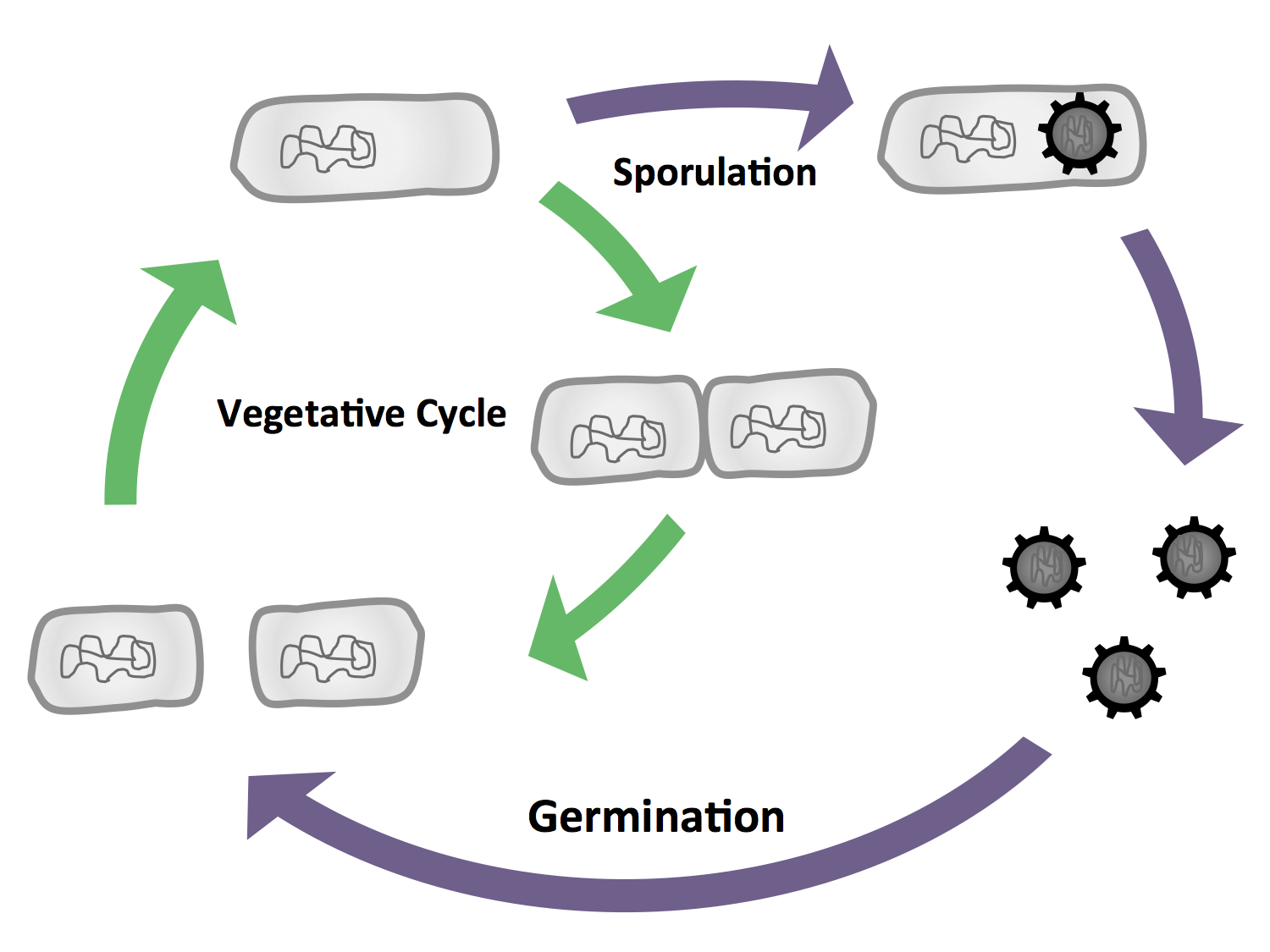Team:LMU-Munich/Bacillus Introduction
From 2012.igem.org
(Created page with "<!-- Include the next line at the beginning of every page --> {{:Team:LMU-Munich/Templates/Page Header|File:Bacillus in urban culture.jpg}} Normally E. coli is used as the gener...") |
|||
| Line 3: | Line 3: | ||
Normally E. coli is used as the general chassis in the iGEM competition. We are using B. subtilis as chassis for a few reasons. To outline this the differences between E. coli and B. subtilis will be shown. There are two major differences between B. subtilis and E. coli that are of interest to us: | Normally E. coli is used as the general chassis in the iGEM competition. We are using B. subtilis as chassis for a few reasons. To outline this the differences between E. coli and B. subtilis will be shown. There are two major differences between B. subtilis and E. coli that are of interest to us: | ||
| + | |||
1. B. subtilis is able to differentiate into cells with different morphology and function, the most severe form being the endospore which is formed under stress conditions. But there are also phenomena like cannibalism which makes B. subtilis a lot more diverse to work with. We will exploit the production of endospores in our project BEADzillus. The life cycle of B. subtilis is depicted in figure 1. | 1. B. subtilis is able to differentiate into cells with different morphology and function, the most severe form being the endospore which is formed under stress conditions. But there are also phenomena like cannibalism which makes B. subtilis a lot more diverse to work with. We will exploit the production of endospores in our project BEADzillus. The life cycle of B. subtilis is depicted in figure 1. | ||
| + | |||
| + | |||
2. B. subtilis can replicate exogenic DNA via an origin of replication on a plasmid as E. coli does, but there is a much more elegant way of bringing in exogenic DNA stretches. When flanked by homologous regions to the bacterial genome, it will integrate at high efficiency via homologous recombination at this loci and furthermore be replicated with the genome. This has the advantage that if comparing different things, not only the enviroment is always the same, but also the copy number is from cell to cell and from strain to strain the same, which is not always the case for replicative plasmids. This integrative way of bringing in exogenic DNA will be exploited by us when producing the BioBrick compatible Bacillus vectors. The comparision between these two ways of bringing in exogenic DNA is depicted in figure 2. | 2. B. subtilis can replicate exogenic DNA via an origin of replication on a plasmid as E. coli does, but there is a much more elegant way of bringing in exogenic DNA stretches. When flanked by homologous regions to the bacterial genome, it will integrate at high efficiency via homologous recombination at this loci and furthermore be replicated with the genome. This has the advantage that if comparing different things, not only the enviroment is always the same, but also the copy number is from cell to cell and from strain to strain the same, which is not always the case for replicative plasmids. This integrative way of bringing in exogenic DNA will be exploited by us when producing the BioBrick compatible Bacillus vectors. The comparision between these two ways of bringing in exogenic DNA is depicted in figure 2. | ||
For these reasons in some cases B. subtilis can be the chassis of choice. Sadely only very few teams have worked with this chassis and there is by time no established BioBrick system to use B. subtilis as a chassis. A short overview over what teams have done so far with B. subtilis is given in table 1. | For these reasons in some cases B. subtilis can be the chassis of choice. Sadely only very few teams have worked with this chassis and there is by time no established BioBrick system to use B. subtilis as a chassis. A short overview over what teams have done so far with B. subtilis is given in table 1. | ||
| + | |||
| + | [[File:Figures Bacillus Intro fig1.png]] | ||
Figure 1: The vegetative cycle is very similiar to the one of E. coli. But if there is a stress condition like starvation, the cells enter Sporulation, where they first undergo a polar cell division, followed by the formation of the Endospore. If the enviromental conditions are friendly again, the Spore will then germinate and reenter the vegetative cycle. | Figure 1: The vegetative cycle is very similiar to the one of E. coli. But if there is a stress condition like starvation, the cells enter Sporulation, where they first undergo a polar cell division, followed by the formation of the Endospore. If the enviromental conditions are friendly again, the Spore will then germinate and reenter the vegetative cycle. | ||
| + | |||
| + | [[File:Figures Bacillus Intro fig2.png]] | ||
Figure 2: Exogenic DNA is shown in red while the bacterial genome is black a) The propagation of exogenic DNA if brought in as replicative plasmid. The number of plasmids per cell can vary. b) The propagation of exogenic DNA if it is able to integrate into the genome via homologous recombination | Figure 2: Exogenic DNA is shown in red while the bacterial genome is black a) The propagation of exogenic DNA if brought in as replicative plasmid. The number of plasmids per cell can vary. b) The propagation of exogenic DNA if it is able to integrate into the genome via homologous recombination | ||
Revision as of 11:25, 20 August 2012

The LMU-Munich team is exuberantly happy about the great success at the World Championship Jamboree in Boston. Our project Beadzillus finished 4th and won the prize for the "Best Wiki" (with Slovenia) and "Best New Application Project".
[ more news ]

Normally E. coli is used as the general chassis in the iGEM competition. We are using B. subtilis as chassis for a few reasons. To outline this the differences between E. coli and B. subtilis will be shown. There are two major differences between B. subtilis and E. coli that are of interest to us:
1. B. subtilis is able to differentiate into cells with different morphology and function, the most severe form being the endospore which is formed under stress conditions. But there are also phenomena like cannibalism which makes B. subtilis a lot more diverse to work with. We will exploit the production of endospores in our project BEADzillus. The life cycle of B. subtilis is depicted in figure 1.
2. B. subtilis can replicate exogenic DNA via an origin of replication on a plasmid as E. coli does, but there is a much more elegant way of bringing in exogenic DNA stretches. When flanked by homologous regions to the bacterial genome, it will integrate at high efficiency via homologous recombination at this loci and furthermore be replicated with the genome. This has the advantage that if comparing different things, not only the enviroment is always the same, but also the copy number is from cell to cell and from strain to strain the same, which is not always the case for replicative plasmids. This integrative way of bringing in exogenic DNA will be exploited by us when producing the BioBrick compatible Bacillus vectors. The comparision between these two ways of bringing in exogenic DNA is depicted in figure 2.
For these reasons in some cases B. subtilis can be the chassis of choice. Sadely only very few teams have worked with this chassis and there is by time no established BioBrick system to use B. subtilis as a chassis. A short overview over what teams have done so far with B. subtilis is given in table 1.
Figure 1: The vegetative cycle is very similiar to the one of E. coli. But if there is a stress condition like starvation, the cells enter Sporulation, where they first undergo a polar cell division, followed by the formation of the Endospore. If the enviromental conditions are friendly again, the Spore will then germinate and reenter the vegetative cycle.
Figure 2: Exogenic DNA is shown in red while the bacterial genome is black a) The propagation of exogenic DNA if brought in as replicative plasmid. The number of plasmids per cell can vary. b) The propagation of exogenic DNA if it is able to integrate into the genome via homologous recombination
 "
"





